The suburb now known as Sandgate was originally known as Cabbage Tree Creek. Sandgate as a name is said to derive from the name of the town of Sandgate in Kent, England, which is also a seaside district.
Before European settlement, however, The Aboriginal name was Warra, meaning a stretch or expanse of water. In this area, from what is now Nudgee Beach to the Pine River, Yugarabul-speaking people have lived off the natural resources that the foreshore, creeks and wetlands of Moreton Bay (or Moora as it's known in Yugarabul) has provided for thousands of years. It is recorded that the Turrbal clan camped close to the Third Lagoon and also the in the area of what we know as the Sandgate Golf Club. Another campsite was at the mouth of the Bald Hills Creek and it is recorded that a sacred burial may have existed somewhere between Bald Hills Creek and Deep Water Bend. A ceremonial site is known to have existed at the Nudgee Water Holes and oral history records a Bora ring at Bald Hills. Dinah Island at the junction of Nundah and Cabbage Trees Creeks was a sacred burial ground and the last recorded burial was for King Johnny in 1892. Red and yellow ochre, which was used for ceremonies, was gathered from a ridge at Brighton. In the coastal branch of the Turrbal tribe each woman had the two joints of one little finger taken off before they entered adulthood.
[This Aboriginal history of the Sandgate area has been sourced from the Keep Sandgate Beautiful Association, with more information available on their page here. For more information on Aboriginal history in Queensland, view our Aboriginal and Torres Strait Islander collections page. Additionally, you can find our Indigenous languages map of Queensland here.]
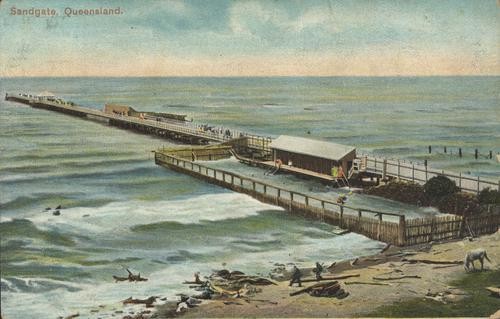
Sandgate beach and pier. Image No: 194855
Some of the early activity and some of the early settlers in the area includes:
- the first early lobbying for a settlement in the Cabbage Tree Creek area commenced from 1852.
- J.C. Burnett undertook an official land survey of the area (1852). The name Sandgate was first used as an official name in his published survey report.
- the site for the proposed village of Sandgate is gazetted (19 March 1853).
- the first official land sales in the area take place (9 November 1853).
- the first purchasers or settlers include Thomas Dowse and John Baxter (from 1853).
- the Slaughter, Davie and Loudin families settle from 1864/5. Mr. Slaughter became the first postmaster for the district.
- the first hotel, known as the Sandgate Hotel established by Charles Davie (1858).
- John Baxter’s café was established at Cabbage Tree Creek (1862).
- seaside cottages are listed in newspapers as being available for rent at £3 per week (late 1860s).
- there is growth in the number of accommodation houses including Villa Marina, Belair, Musgrave (from the 1870s).
- a horse drawn coach service was established by the Best family.
- soft drink manufacturing commenced from the 1880s.
- Hoffy’s Cycles established (1928).
- Jeay’s Hardware.
- Frank Watson’s Kreamo ice cream factory.
- clay quarries.
- Sandgate Aerated Water Company, later to be known as Ibis established in the 1920s.
- Pelaco shirt factory (post World War Two).
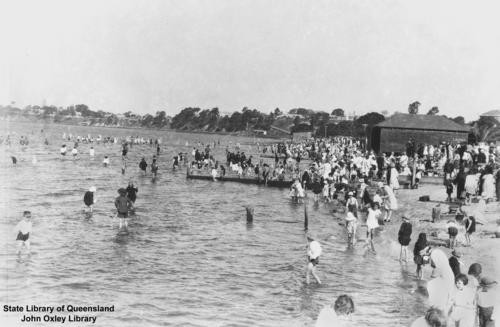
Bathers at Sandgate, ca. 1925 Image No: 60888
Some significant buildings and sites in Sandgate include:
- Shepherd Place – Signal Row (named after Hezekiah Shepherd).
- Murilla – Signal Row (1908).
- Wesleyan Church – Signal Row (approx 1908).
- Morven – this was the home of John McConnel, the owner of Durundur Station and dates from 1863. The house was eventually acquired by Archbishop Duhig for the Catholic Church. Morven is now located in the grounds of St. Patrick’s College.
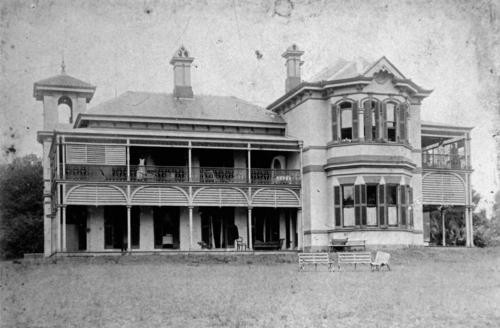
Morven, ca. 1912 Image No: 122956
- Caversham – built by Robert Gray in 1882.
- Clutha – built by Dr. John Thomas in 1882.
- Saltwood – built by G. L. Hart in 1870.
- Moora Park Grandstand – dates from the 1890s.
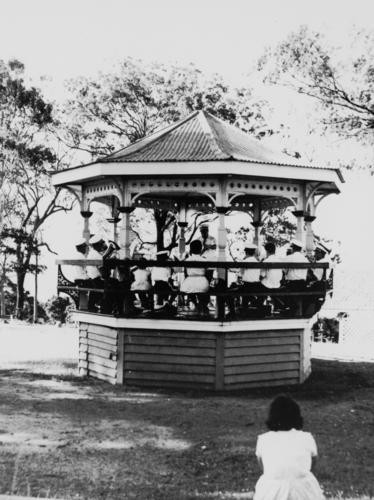
Grandstand in Moora Park Image No: 89952
- Musgrave House – originally a childrens’ convalescent home (1884).
- the Sandgate Hotel, later to be known as the Belvedere Hotel, established by Charles Davie (1858).
- the Claredon Hotel (David Mitchell) (1861).
- 1862 – the Sandgate Hotel, built by William Loudin in 1862. This was a different hotel to the Sandgate Hotel mentioned above, which by this time was trading as the Belvedere Hotel.
- the London Hotel built in 1863 for Thomas Cahill. This hotel was abandoned in 1864.
- 1865 – Brighton Hotel built for William Rae and dating from 1865.
- Masons Hotel (George Mason).
- 1867 – the Osbourne Hotel built for Hiram Wakefield (1867).
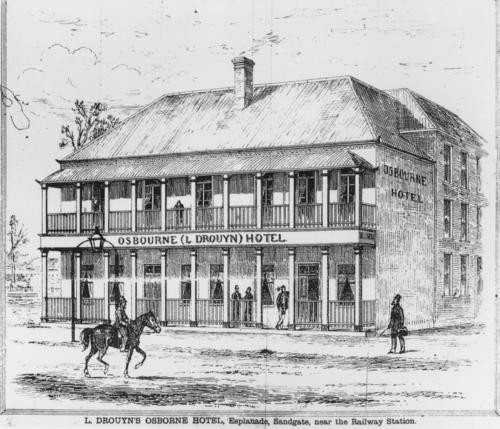
Osbourne Hotel, 1882 Image No: 110667
- 1881 – the Seaview Hotel established by Robert Todd in 1881.
- 1861 – a bridge across Cabbage Tree Creek was constructed.
- 1865 – a company is formed with the aim of constructing the Sandgate Pier.
- 1868 – a regular coach service between Brisbane and Sandgate was established. In the initial phase this was not a daily service.
- 1873 – Sandgate State School was established with the original classes being held in the chapel of the Baptist Church. The first teacher was W.R. Barfoot.
- 1874 – the first permanent Sandgate State School building was constructed.
- 1876 – daily coach services from Brisbane to Sandgate, via Nundah commence.
- 1880 – Sandgate was proclaimed a Municipal Borough.
- 1880 – Sandgate was proclaimed a Town. The names of some of the first Town Councillors are honoured in the names of local streets including Townsend, Board, Bott, Kift and Deagon streets.
- 1881 – a railway construction contract was awarded for construction of a line to Sandgate.
- 1882 – (11 May) the railway line to Sandgate was opened.
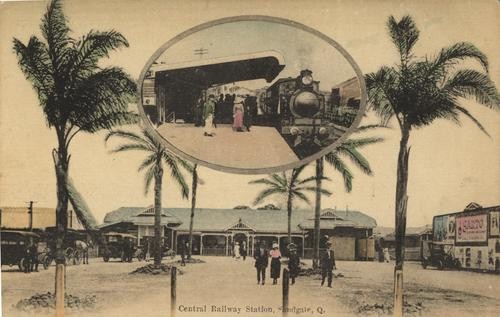
Sandgate Railway Station, ca. 1920 Image No: 194780
- 1887 – the Sandgate Post Office was established.
- 1912 – the new Sandgate Town Hall was constructed to replace the original chambers which were destroyed by fire in 1910.
- 1915 – the Sandgate Drill Hall was opened, possibly replacing an earlier building. The Drill Hall was recently moved to the Chermside Historical Precinct.
- 1919 – the Shorncliffe State School was established.
- 1935 – the Hornibrook Highway was opened.
Comments
Your email address will not be published.
We welcome relevant, respectful comments.